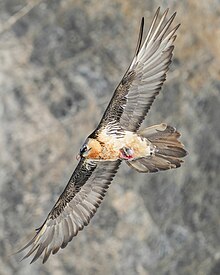| Bearded vulture | |
|---|---|

| |
| Scientific classification | |
| Domain: | Eukaryota |
| Kingdom: | Animalia |
| Phylum: | Chordata |
| Class: | Aves |
| Order: | Accipitriformes |
| Family: | Accipitridae |
| Subfamily: | Gypaetinae |
| Genus: | Gypaetus Storr, 1784 |
| Species: | G. barbatus
|
| Binomial name | |
| Gypaetus barbatus | |
| Subspecies[2] | |
| |

| |
| Distribution of Gypaetus barbatus Resident Non-breeding Probably extinct Extinct Possibly extant (resident) Extant & reintroduced (resident)
| |
| Synonyms | |
| |
The bearded vulture (Gypaetus barbatus), also known as the lammergeier and ossifrage, is a very large bird of prey in the monotypic genus Gypaetus. Traditionally considered an Old World vulture, it actually forms a separate minor lineage of Accipitridae together with the Egyptian vulture (Neophron percnopterus), its closest living relative. It is not much more closely related to the Old World vultures proper than to, for example, hawks, and differs from the former by its feathered neck. Although dissimilar, the Egyptian and bearded vulture each have a lozenge-shaped tail—unusual among birds of prey. It is vernacularly known as Homa, a bird in Iranian mythology.[3]
The bearded vulture population is thought to be in decline; in 2004, it was classified on the IUCN Red List as least concern but has been listed as near threatened since 2014. It lives and breeds on crags in high mountains in Iran, southern Europe, East Africa, the Indian subcontinent, Tibet,[1] and the Caucasus. Females lay one or two eggs in mid-winter that hatch at the beginning of spring. The bearded vulture is the only known vertebrate whose diet consists of 70–90% bone.[4]
- ^ a b BirdLife International (2021). "Gypaetus barbatus". IUCN Red List of Threatened Species. 2021: e.T22695174A154813652. doi:10.2305/IUCN.UK.2021-3.RLTS.T22695174A154813652.en. Retrieved 19 November 2021.
- ^ Gill F, D Donsker & P Rasmussen (Eds). 2021. IOC World Bird List (v11.1). doi:10.14344/IOC.ML.11.1
- ^ "Homa- A Mythical Bird of Iranian Legends". February 2022.
- ^ "Bearded vulture". wwf.panda.org.
